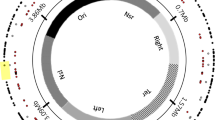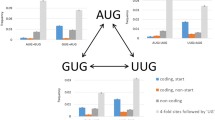Abstract
The large open reading frames of insertion sequences from Escherichia coli were examined for their spatial pattern of codon usage bias and distribution of rarely used codons. There is a bias in codon usage that is generally lower toward the terminal ends of the coding regions, which is reflected in the occurrence of an excess of nonpreferred codons in the 3′ portions of the coding regions as compared with the 5′ portions. In contrast, typical chromosomal genes have a lower codon usage bias toward the 5′ ends of the coding regions. These results imply that the selective forces reflected in codon usage bias may differ according to position within the coding sequence. In addition, these constraints apparently differ in important ways between genes contained in insertion sequences and those in the chromosome.
Similar content being viewed by others
References
Ayer, D. & Yarus, M., 1986. The context effect does not require a fourth base pair. Science 231: 393–395.
Bennetzen, J. L. & Hall, B. D., 1982. Codon selection in yeast. J. Biol. Chem. 257: 3026–3031.
Bulmer, M., 1988. Codon usage and intragenic position. J. Theor. Biol. 133: 67–71.
Blundell, M., Craig, E. & Kennell, D., 1972. Decay rates of different mRNA in E. coli and models of decay. Nature New Biol. 238: 46–49.
Bonekamp, F., Andersen, H. D., Christensen, T. & Jensen, K. F., 1985. Codon-defined ribosomal pausing detected by using the pyrE attenuator to probe the coupling between transcription and translation. Nuc. Acids Res. 13: 4113–4123.
Bossi, L., 1983. Context effects: Translation of UAG codon by suppressor tRNA is affected by the sequence following UAG in the message. J. Mol. Biol. 164: 73–87.
Bossi, L. & Roth, J. R., 1980. The influence of codon context on genetic code translation. Nature 286: 123–127.
Burns, D. M. & Beacham, I. R., 1985. Rare codons in E. coli and S. typhimurium signal sequences. FEBS Lett. 189: 318–324.
Cannistraro, V. J., Subbarao, M. N. & Kennell, D., 1986. Specific endonucleolytic cleavage sites for decay of Escherichia coli mRNA. J. Mol. Biol. 192: 257–274.
Carter, P. W., Bartkus, J. M. & Calvo, J. M., 1986. Transcription attenuation in Salmonella typhimurium: the significance of rare leucine codons in the leu leader. Proc. Nat. Acad. Sci., USA 83: 8127–8131.
Dix, D. B. & Thompson, R. C., 1989. Codon choice and gene expression: Synonymous codons differ in translational accuracy. Proc. Nat. Acad. Sci., USA 86: 6888–6892.
Galas, D. J. & Chandler, M., 1989. Bacterial Insertion Sequences, pp. 109–162 in Mobile DNA, edited by D. E.Berg and M. M.Howe. American Society for Microbiology, Washington, D.C.
Grindley, N. D. F. & Joyce, C. M., 1981. Analysis of the structure and function of the kanamycin-resistance transposon Tn903. Cold Spring Harb. Symp. Quant. Biol. 45: 125–133.
Gouy, M. & Gautier, C., 1982. Codon usage in bacteria: correlation with gene expressivity. Nuc. Acids Res. 10: 7055–7074.
Gutman, G. A. & Hatfield, G. W., 1989. Nonrandom utilization of codon pairs in Escherichia coli. Proc. Nat. Acad. Sci., USA 86: 3699–3703.
Harms, E. & Umbarger, H. E., 1987. Role of codon choice in the leader region of the ilvGMEAA operon of Serratia marcescens. J. Bacteriol. 169: 5668–5677.
Holm, L., 1986. Codon usage and gene expression. Nuc. Acids Res. 14: 3075–3087.
Ikemura, T., 1981. Correlation between the abundance of Escherichia coli transfer RNAs and the occurrence of the respective codons in its protein genes. J. Mol. Biol. 146: 1–21.
Ikemura, T., 1985. Codon usage and tRNA content in unicellular and multicellular organisms. Mol. Biol. Evol. 2: 13–34.
Jack, H. M., Berg, J. & Wahl, M., 1987. Translation affects immunoglobulin mRNA stability. Eur. J. Immunol. 19: 843–847.
Kennell, D. E., 1986. The instability of messenger RNA in bacteria, pp. 101–142 in Maximizing Gene Expression, edited by W. S.Reznikoff and L.Gold. Butterworths, Stoneham, MA.
Kepes, A., 1967. Sequential transcription and translation in the lactose operon of Escherichia coli. Biochim. Biophys. Acta 138: 107–123.
Levinthal, C., Fan, D. P., Higa, A. & Zimmermann, R. A., 1963. The decay and protection of messenger RNA in bacteria. Cold Spring Harb. Symp. Quant. Biol. 28: 183–190.
Lijenström, H. & VonHeijne, G., 1987. Translation rate modification by preferential codon usage: intragenic position effects. J. Theor. Biol. 124: 43–55.
Machida, Y., Machida, C., Ohtsubo, H. & Ohtsubo, E., 1982. Factors determining frequency of plasmid cointegration mediated by insertion sequence IS1. Proc. Nat. Acad. Sci., USA 79: 277–281.
Misra, S. & Rio, C., 1990. Cytotype control of Drosophila P element transposition: The 66 kd protein is a repressor of transposase activity. Cell 40: 269–284.
Morisato, D., Way, J. C., Kim, H.-J. & Kleckner, N., 1983. Tn10 transposase acts preferentially on nearby transposon ends in vivo. Cell 32: 799–807.
Morse, D. E. & Yanosfky, C., 1969. Polarity and the degradation of mRNA. Nature 224: 329–331.
Petersen, C., 1987. The functional stability of the lacZ transcript is sensitive towards sequence alterations immediately downstream of the ribosome binding site. Mol. Gen. Genet. 209: 179–187.
Reimmann, C., Moore, R., Little, S., Savioz, A., Willetts, N. S. & Haas, D., 1989. Genetic structure, function, and regulation of the transposable element IS21. Mol. Gen. Genet. 214: 416–424.
Robinson, M., Lilley, R., Little, S., Emtage, J. S., Yarranton, G., Stephens, P., Millican, A., Eaton, M. & Humphreys, G., 1984. Codon usage can affect efficiency of translation of genes in Escherichia coli. Nuc. Acids Res. 12: 6663–6671.
Sawyer, S. A., Dykhuizen, D. E., DuBose, R. F., Green, L., Mutangadura-Mhlanga, T., Wolczyk, D. F. & Hartl, D. L., 1987. Distribution and abundance of insertion sequences among natural isolates of Escherichia coli. Genetics 115: 51–63.
Sekine, Y. & Ohtsubo, E., 1989. Frameshifting is required for production of the transposase encoded by insertion sequence 1. Proc. Nat. Acad. Sci., USA 86: 4609–4613.
Sharp, P. M. & Li, W. H., 1986. Codon usage in regulatory genes in Escherichia coli do not reflect selection for ‘rare’ codons. Nuc. Acids Res. 14: 7737–7749.
Sharp, P. M. & Li, W. H., 1987a. Rate of synonymous substitution in Enterobacterial genes in inversely related to codon usage bias. Mol. Biol. Evol. 4: 222–230.
Sharp, P. M. & Li, W. H., 1987b. The codon adaptation index—a measure of directional synonymous codon usage bias, and its potential applications. Nuc. Acids Res. 15: 1281–1295.
Sharp, P. M., Cowe, E., Higgins, D. G., Shields, D. C., Wolfe, K. H. & Wright, F., 1988. Codon usage patterns in Escherichia coli, Bacillus subtilus, Saccharomyces cerevisiae, Schizosaccha romyces pombe, Drosophila melanogaster, and Homo sapiens; a review of the considerable within species diversity. Nuc. Acids Res. 16: 8207–8211.
Stadler, R., Caspers, P., Olasz, F. & Arber, W., 1990. The N-terminal domain of the insertion sequence 30 transposase interacts specifically with the terminal inverted repeats of the element. J. Biol. Chem. 265: 3757–3762.
Thompson, R. C., Dix, D. B. & Eccleston, J. F., 1980. Single tunover kinetic studies of guanosine triphosphate hydrolysis and peptide formation in the elongation factor Tu dependent binding of aminoacyl-tRNA to Escherichia coli ribosomes. J. Biol. Chem. 255: 11088–11090.
vonGabain, A., Belasco, J. G., Schottel, J. C., Chang, A. C. Y. & Cohen, S. N., 1983. Decay of mRNA in Escherichia coli: Investigation of the fate of specific segments of transcripts. Proc. Nat. Acad. Sci., USA 80: 653–657.
Wikström, P. M. & Björk, G. R., 1989. A regulatory element within a gene of a ribosomal protein operon of Escherichia coli negatively controls expression by decreasing the translational efficiency. Mol. Gen. Genet. 219: 381–389.
Varenne, S., Buc, J., Lloubes, R. & Lazdunski, C., 1984. Translation is a non-uniform process: effect of tRNA availability on the rate of elongation of nascent polypeptide chains. J. Mol. Biol. 180: 549–576.
Yarus, M., 1979. The accuracy of translation. Prog. Nuc. Acid Res. Mol. Biol. 23: 195–225.
Yarus, M., & Folley, L. S., 1985. Sense codons are found in specific contexts. J. Mol. Biol. 182: 529–540.
Zerbib, D., Jakowec, M., Prentki, P., Galas, D. & Chandler, M., 1987. Expression of proteins essential for IS1 transposition: specific binding of InsA to the ends of IS1. EMBO J. 6: 3163–3169.
Author information
Authors and Affiliations
Rights and permissions
About this article
Cite this article
Lawrence, J.G., Hartl, D.L. Unusual codon bias occurring within insertion sequences in Escherichia coli . Genetica 84, 23–29 (1991). https://doi.org/10.1007/BF00123981
Received:
Accepted:
Issue Date:
DOI: https://doi.org/10.1007/BF00123981




